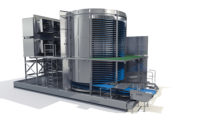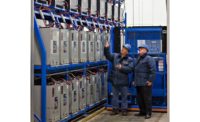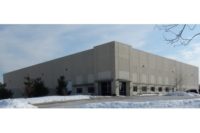Bakers and snack food producers need to consider many factors when it comes to cold storage and refrigeration, including whether they purchase their own equipment or use a third-party provider. Energy efficiency, food safety, government regulations and a variety of other issues all require evaluation.
Energy costs related to cold-storage facilities can reach tens of thousands of dollars per month, says Michael G. Smith, director of project development, Stellar, Jacksonville, FL, an architecture, engineering, construction and mechanical services firm that designs and constructs cold storage facilities, as well as other industrial facilities.
“At Stellar, we focus on the building envelope and constructing a vapor barrier,” explains Smith. “Numerous thermal details must be considered, including insulation thickness for the floors, walls and roof; low-temperature door systems; and the use of insulated metal panels for adequate vapor seals. All construction materials have the potential to impact profitability and food safety.”
Stellar employs an integrated approach to optimizing the mechanical system, along with an automation strategy to reduce energy costs. Automation enables plant engineers to generate trend analyses, alarm logs, energy management data and runtime reports in real time. “This data allows them to make the necessary changes and modifications to ensure the refrigeration system is running at optimum efficiency,” adds Smith.
Cold storage facilities are also facing new refrigeration challenges as regulatory requirements call for the reduction or elimination of certain chemicals, according to Smith. Ozone-depleting HCFC-22 or R-22 refrigerant (chlorodifluoromethane) is being phased out in the United States, so environmentally friendly alternatives are needed. “While ammonia continues to be the most-popular replacement, many facilities are considering the use of glycol and CO2,” he explains.
Cold and clean
Another issue bakers and snack producers must consider with when investing in or using cold storage or refrigeration facilities is sanitation.
Able Freight Services Inc., Los Angeles, recently integrated NASA-developed AiroCide air sanitation technology into its cold storage warehouses as added protection against environmental pathogens. The company handles and exports 75,000 tons of perishables annually. “Since installing AiroCide, we’ve been satisfied with the air sanitation technology,” says Peter Dauer, food-safety coordinator for the company.
Available from KES Science & Technology Inc., Kennesaw, GA, the AiroCide system destroys airborne mold, fungi, food allergens, bacteria, odors, viruses and volatile organic compounds (VOCs), such as ethylene gas. The destruction of airborne pathogenic microorganisms and VOCs takes place inside the AiroCide chamber.
“Contaminated air is continuously processed through a bio-conversion reactor bed,” explains John J. Hayman Jr., director of science and technology, KES. “All organic materials are mineralized, leaving the exit air 99% contaminant-free. No ozone is utilized or produced during the process.”
Hayman says AiroCide complements quality assurance and food-safety best-practice programs, while maximizing product shelf life and assuring product integrity.
Third-party providers
The third-party option offers manufacturers certain advantages, says Ken Johnson, senior vice president of operations, MTC Logistics, Baltimore, a refrigerated and frozen warehousing company. Going with a third party allows companies to bid on programs that they cannot handle alone because they lack the storage and distribution space, he explains. “It gives them the opportunity to level out their production to meet the seasonal needs of their customers.”
For example, Johnson says bakers who supply buns to high-volume, fast-food operations often don’t have enough freezer space to freeze their own product as well as distribute it to end users. “So, during holidays, we receive, store and distribute their bread products well in advance of the given holiday,” he explains. “This allows them to spread out their production to manageable levels.”
Freezer options
Bakers and snack manufacturers that decide to invest in their own cold storage or refrigeration units also have a variety of options from which to choose.
Praxair Inc., Danbury, CT, manufactures in-line cryogenic freezing and chilling systems that allow bakery and snack food processors to quickly chill products to retain appearance, quality and shape for packaging.
“We offer bakery customers cryogenic freezers that save space and can be installed quickly,” says Frank J. Martin, marketing manager, food refrigeration, for the company. “We build our tunnel freezers in modular design and have installed them as short as 9 ft. long and up to 81 ft. long, based on product freezing rates, heat removal and desired production rates.”
One of Praxair’s recent innovations is an Ultra Performance tunnel freezer that uses a unique airflow that reduces tunnel length by 30%, while providing improved sanitation—attributes that are both beneficial to the bakery and snack food industries, Martin adds. Another new design is the ColdFront Cryo-Saver tunnel freezer, which provides 15% efficiency improvement over standard cryogenic freezers.
Master-Bilt Products, New Albany, MS, manufactures walk-in coolers, freezers and warehouses that keep bakery-related products fresh and help them avoid bacterial formation. “Our walk-in panels are polyurethane foamed-in-place for the most dependable insulation,” says Lynn Burge, marketing manager for the company. “As a barricade between perishable items inside and warmer temperatures outside, our standard entry doors withstand the numerous openings and closings of a typical business day without losing structural integrity.”
From a minimum 6-ft.-by-6-ft. size to more elaborate 10,000-sq.-ft. warehouses, Master-Bilt walk-in refrigeration systems can be customized to provide the right amount of temperature-controlled space, she adds. Basic modular panel sizes and heights, as well as many options, offer flexibility to fulfill various design requirements.
Freezer components
While GEA Refrigeration North America, York, PA, does not design cold storage systems, the company does provide system components such as compressor packages and refrigeration control systems. Two of its newest components are the GEA Omni control panel and the V Series reciprocating compressor package.
The Omni control panel features a high-definition, multitouch screen. It integrates and coordinates all required system components and enables demand-driven and highly energy-efficient facility operation, the company reports. The V Series compressor features electronically controlled service intervals (extended as well as flexible), which reduce total cost of ownership.
Ashworth Bros. Inc., Winchester, VA, manufactures Omni-Pro and Omni-Flex metal conveyor belts, which are designed for refrigerated applications. “Bakers and snack food producers that freeze products prior to moving them into cold storage should select a belt for their spiral freezer that will not trap heat between the product and belt surface,” says Kenneth King, commercial support manager. “Traditional, all-plastic belt designs utilize modules with increased mass in order to support product load within a spiral freezing system. These modules can act as an insulator, trapping heat between the surface of the belt and the product. This exterior moisture can impact product appearance and reduce product shelf life.”
Because metal belts do not have insulating properties, they maintain a consistent surface temperature equivalent to the desired freezing temperature within the spiral system, says King. This eliminates potential for moisture, in the form of frost, to build up on the product surface, thus preventing product quality and shelf-life issues down the road.
Bakers and snack food manufacturers face many challenges when developing and creating their products. Keeping the results of their labor fresh and safe shouldn’t be one of them. Today’s cold storage and refrigeration options can put those concerns on ice.







